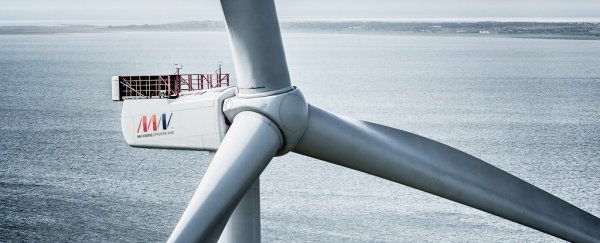A new offshore wind turbine has produced more energy over a 24-hour period than any other commercially available turbine, generating close to almost 216,000 kilowatt-hours (kWh) in a single day.
That's enough to power around 7,200 homes in the US on its own for 24 hours, though this particular turbine is being tested near Østerild in Denmark, and will soon be deployed in Europe.
The V164 was recently upgraded to reach 9 megawatts (MW) of rated power – an impressive boost, considering many modern offshore turbines in use today are in the 4 to 6 MW range.
With testing complete and the new record set on 1 December 2016, the next step for the turbine's Danish operator, MHI Vestas Offshore Wind, is to get the machine connected to the grid.
"We are confident that the 9 MW machine has now proven that it is ready for the market, and we believe that our wind turbine will play an integral part in enabling the offshore industry to continue to drive down the cost of energy," says company CTO, Torben Hvid Larsen.
 MHI Vestas Offshore Wind
MHI Vestas Offshore Wind
As turbines get larger and more powerful, more energy can be generated with fewer of them, improving efficiency and value for money, and reducing the cost of this form of renewable energy.
And the V164 is certainly large: its 'swept area' – the area covered by the blades – is 21,124 square metres (more than 227,000 square feet), which means it stretches further than the spokes and cable cars of the London Eye.
Each blade is 80 metres (262 feet) in length and weighs 35 tonnes, and the whole turbine stands some 220 metres (722 feet) tall. For some context, that's two-thirds of the way up the Eiffel Tower.
The turbine is based on an earlier 8 MW model, and is designed to handle harsh North Sea winds of 12-25 metres per second (27-56 miles per hour).
It's built to last too: as Megan Treacy reports at Treehugger, the V164 has a lifespan of 25 years, and 80 percent of it can be recycled to be used again.
Energy companies are already interested in tapping into the V164's potential, and this certainly won't be the last turbine to break records: scientists estimate the cost of wind energy could drop by a quarter by 2030 as turbines get more efficient at converting wind power into electricity.
Recent reports show prices have been dropping steadily in the US over the last few years, and offshore wind farms are close to rivalling conventional gas and coal sources of power in the European Union.
While less windy regions of the world may be more environmentally suited to other forms of renewable energy, it's clear that wind power still has huge gains to make: Harvard University researchers have estimated that the technology has the potential to produce up to 40 times the electricity the world currently consumes.
All of which means the V164 and its successors have the potential to break many more records in the years ahead.
"Offshore is a reliable and increasingly cheap source of energy, with no lasting harm to the environment," vice president of Dong Energy Wind Power Benj Sykes recently told The Guardian. "It will soon be simply unbeatable."
It should be noted that there are a number of limitations associated with wind power, including the fact that its daily costs aren't yet cheaper than fossil fuel-based energy forms, and it requires very specific locations to get enough wind.
But if the success of this monster turbine can tell us anything about the future, we're excited to see where the technology leads.
